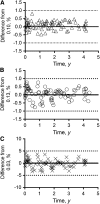The doubly labeled water method produces highly reproducible longitudinal results in nutrition studies
- PMID: 24523488
- PMCID: PMC3985832
- DOI: 10.3945/jn.113.187823
The doubly labeled water method produces highly reproducible longitudinal results in nutrition studies
Abstract
The doubly labeled water (DLW) method is considered the reference method for the measurement of energy expenditure under free-living conditions. However, the reproducibility of the DLW method in longitudinal studies is not well documented. This study was designed to evaluate the longitudinal reproducibility of the DLW method using 2 protocols developed and implemented in a multicenter clinical trial-the Comprehensive Assessment of Long-term Effects of Reducing Intake of Energy (CALERIE). To document the longitudinal reproducibility of the DLW method, 2 protocols, 1 based on repeated analysis of dose dilutions over the course of the clinical trial (dose-dilution protocol) and 1 based on repeated but blinded analysis of randomly selected DLW studies (test-retest protocol), were carried out. The dose-dilution protocol showed that the theoretical fractional turnover rates for (2)H and (18)O and the difference between the 2 fractional turnover rates were reproducible to within 1% and 5%, respectively, over 4.5 y. The Bland-Altman pair-wise comparisons of the results generated from 50 test-retest DLW studies showed that the fractional turnover rates and isotope dilution spaces for (2)H and (18)O, and total energy expenditure, were highly reproducible over 2.4 y. Our results show that the DLW method is reproducible in longitudinal studies and confirm the validity of this method to measure energy expenditure, define energy intake prescriptions, and monitor adherence and body composition changes over the period of 2.5-4.4 y. The 2 protocols can be adopted by other laboratories to document the longitudinal reproducibility of their measurements to ensure the long-term outcomes of interest are meaningful biologically. This trial was registered at clinicaltrials.gov as NCT00427193.
Conflict of interest statement
Author disclosures: W. W. Wong, S. B. Roberts, S. B. Racette, S. K. Das, L. M. Redman, J. Rochon, M. V. Bhapkar, L. L. Clarke, and W. E. Kraus, no conflicts of interest.
Figures


Comment in
-
Doubly labeled water is a validated and verified reference standard in nutrition research.J Nutr. 2014 May;144(5):573-4. doi: 10.3945/jn.114.191361. Epub 2014 Feb 26. J Nutr. 2014. PMID: 24572040 Free PMC article. No abstract available.
References
-
- Lee JS, Lifson N. Measurement of total energy and material balance in rats by means of doubly labeled water. Am J Physiol. 1960;199:238–42. - PubMed
-
- Lifson N, Gordon GB, McClintock R. Measurement of total carbon dioxide production by means of D2O18. J Appl Physiol. 1955;7:704–10. - PubMed
-
- Lifson N, Lee JS. Estimation of material balance of totally fasted rats by doubly labeled water. Am J Physiol. 1961;200:85–8. - PubMed
-
- Lifson N, McClintock R. Theory of use of the turnover rates of body water for measuring energy and material balance. J Theor Biol. 1966;12:46–74. - PubMed
-
- Little WS, Lifson N. Validation study of D218O method for determination of CO2 output of the eastern chipmunk (Tamais striatus). Comp Biochem Physiol Comp Physiol. 1975;50:55–6. - PubMed
Publication types
MeSH terms
Substances
Associated data
LinkOut - more resources
Full Text Sources
Other Literature Sources
Medical

